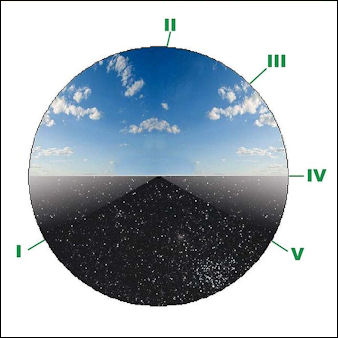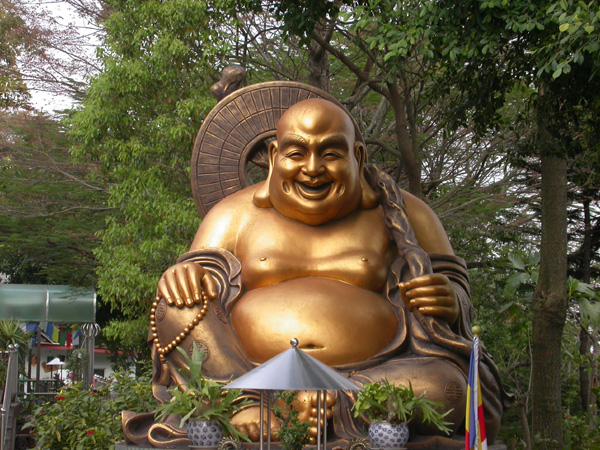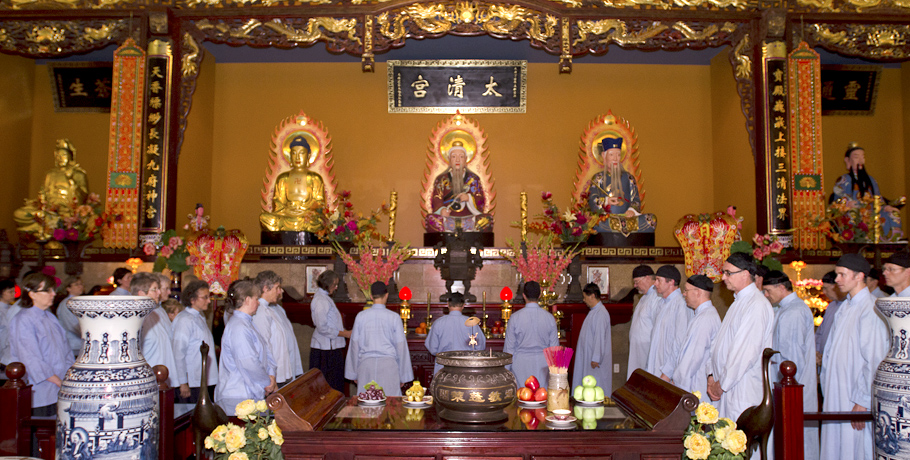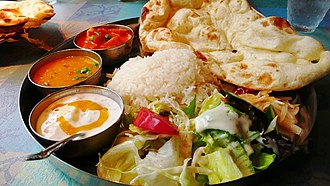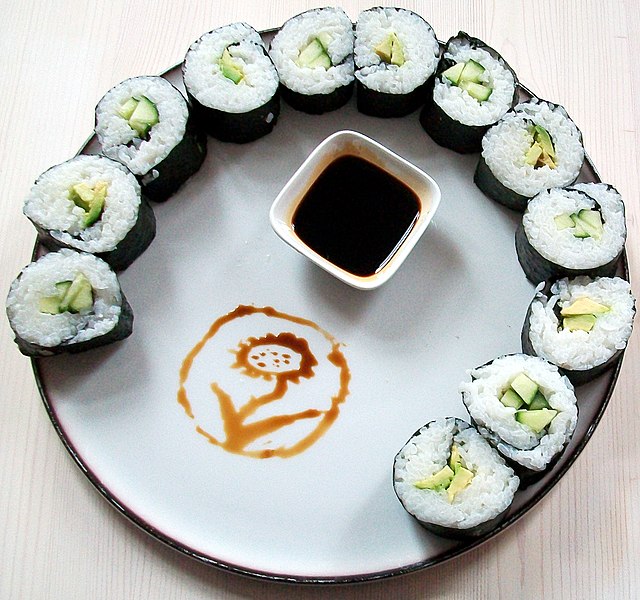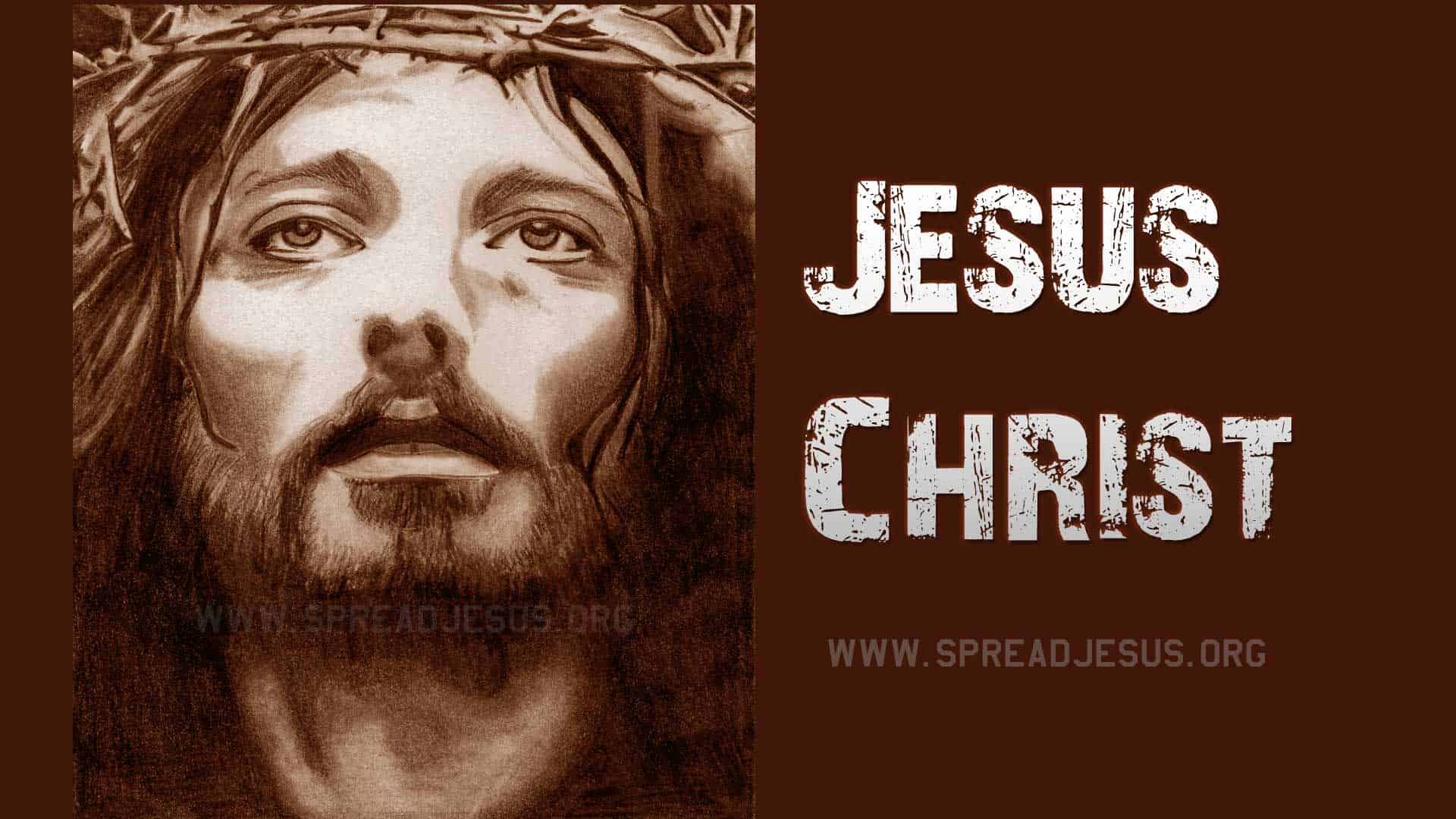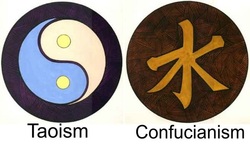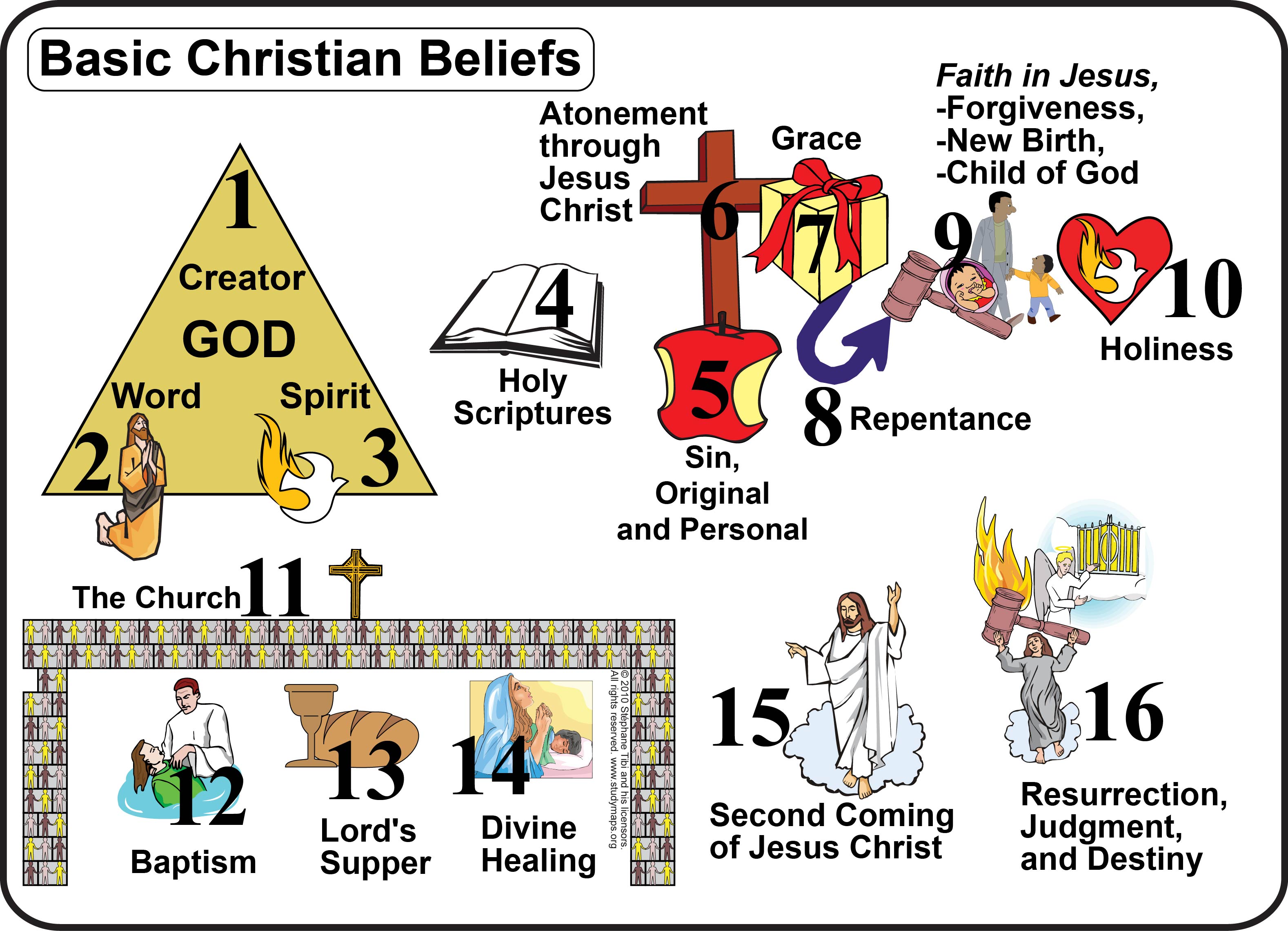Friday, March 27, 2015
Wednesday, March 25, 2015
BASIC RELIGIOUS CONCEPTS
ក.ជំនឿលើព្រះ
១. ទេវនិយម៖ ទស្សនៈស្តីពី (១) ព្រះវិញ្ញាណបរិសុទ្ធ (២) អ្វីៗសុទ្ធតែប្រពៃ (៣) ទ្រង់ញាណដឹងទាំងអស់ (៤) មានឬទ្ធិបារមី
A. Belief in God
1. Theistic God: the concept of a being which is (1) purely spiritual, (2) all good, (3) all knowing, and (4) all powerful.
2. Theism: អាទិទេព
ក.) មានជំនឿថាពិតជាមានព្រះមួយអង្គ
ខ.) មានជំនឿថាក្រៅពីព្រះមួយអង្គនោះ មានព្រះផ្សេងទៀត
a) Narrow: belief in the existence of the theistic God.
b) Broad: Belief in the existence of some divine being other than the theistic God.
3. Atheism:មិនជឿថាមានព្រះ
ក.)មិនថាមានព្រះ
ខ.)មិនជឿថាព្រះ ទោះជាព្រះបែបណាក្តី
a) Narrow: disbelief in theistic God.
b) Broad: disbelief the existence of any divine being whatever.
4. Agnosticism មិនជឿ មិនបដិសេធថាមានព្រះ
ក.)មិនជឿ ក៍មិនថា ជឿក៍មិនថា មានព្រះតែមួយ
ខ.)មិនជឿ ក៍មិនថា ជឿក៍មិនថា មានព្រះណាទៀត
a) Narrow: neither belief nor disbelief in the existence of the theistic God.
b) Broad: neither belief nor disbelief in the existence of any divine being whatever.
B. Types of theism ប្រភេទទេវៈ
1. Animism: belief that inanimate objects (such as statues or mountains) have souls. ជំនឿលើវិញ្ញាណៈ ជំនឿថាវត្ថុមានវិញ្ញាណ (ភ្នំ រូបសំណាក) សុទ្ធតែមានព្រលឹង
2. Polytheism: belief in a multiplicity of gods. មានជំនឿមានព្រះច្រើន
3. Henotheism: polytheistic belief that each nation or country has its own god.ជំនឿថាមានព្រះច្រើនអង្គៈ ជំនឿនេះយល់ថាជាតិសាសន៍មួយ ឬប្រទេសមួយមានព្រះផ្ទាល់ខ្លួន
4. Dualism: polytheistic belief in two conflicting deities, one good and the other evil. ជំនឿថាអ្វីៗគឺជាទ្វីកភាគៈ ជំនឿថាមានល្អ មានអាក្រក់
5. Monotheism: belief in one god, but not necessarily the theistic God. ជំនឿថាមានព្រះតែមួយ តែក៍មិនចាំបាច់មានលទ្ធិព្រះដែរ
6. Deism: monotheistic belief in a god who set the universe in motion and thereafter left it alone. ជំនឿថាព្រះបង្កើតចក្រវាឡ រួចរំលាយអ្វីលើចក្រវាឡចោលវិញ
7. Pantheism: monotheistic belief that god is identical with nature as a whole.ជំនឿគ្រប់អាទិទេពទាំងអស់ៈ ជំនឿថាព្រះមាននៅគ្រប់អ្វីៗទាំងអស់
C. Revelation
1. Special revelation: divine revelation to humans which is (a) specific in content, and (b) for a specific audience (such as the Bible or the Koran).
2. General Revelation: divine revelation to humans which is (a) general in content, and (b) for a general audience.
3. Theology: the human attempt to understand special revelation.
4. Natural theology: the human attempt to understand general revelation.
D. Approaches to theistic belief
1. Mysticism: experiencing a union with divine nature by means of ecstatic contemplation.
2. Rationalism: theistic belief from rational grounds.
3. Fideism: theistic belief solely on the grounds of faith.
១. ទេវនិយម៖ ទស្សនៈស្តីពី (១) ព្រះវិញ្ញាណបរិសុទ្ធ (២) អ្វីៗសុទ្ធតែប្រពៃ (៣) ទ្រង់ញាណដឹងទាំងអស់ (៤) មានឬទ្ធិបារមី
A. Belief in God
1. Theistic God: the concept of a being which is (1) purely spiritual, (2) all good, (3) all knowing, and (4) all powerful.
2. Theism: អាទិទេព
ក.) មានជំនឿថាពិតជាមានព្រះមួយអង្គ
ខ.) មានជំនឿថាក្រៅពីព្រះមួយអង្គនោះ មានព្រះផ្សេងទៀត
a) Narrow: belief in the existence of the theistic God.
b) Broad: Belief in the existence of some divine being other than the theistic God.
3. Atheism:មិនជឿថាមានព្រះ
ក.)មិនថាមានព្រះ
ខ.)មិនជឿថាព្រះ ទោះជាព្រះបែបណាក្តី
a) Narrow: disbelief in theistic God.
b) Broad: disbelief the existence of any divine being whatever.
4. Agnosticism មិនជឿ មិនបដិសេធថាមានព្រះ
ក.)មិនជឿ ក៍មិនថា ជឿក៍មិនថា មានព្រះតែមួយ
ខ.)មិនជឿ ក៍មិនថា ជឿក៍មិនថា មានព្រះណាទៀត
a) Narrow: neither belief nor disbelief in the existence of the theistic God.
b) Broad: neither belief nor disbelief in the existence of any divine being whatever.
B. Types of theism ប្រភេទទេវៈ
1. Animism: belief that inanimate objects (such as statues or mountains) have souls. ជំនឿលើវិញ្ញាណៈ ជំនឿថាវត្ថុមានវិញ្ញាណ (ភ្នំ រូបសំណាក) សុទ្ធតែមានព្រលឹង
2. Polytheism: belief in a multiplicity of gods. មានជំនឿមានព្រះច្រើន
3. Henotheism: polytheistic belief that each nation or country has its own god.ជំនឿថាមានព្រះច្រើនអង្គៈ ជំនឿនេះយល់ថាជាតិសាសន៍មួយ ឬប្រទេសមួយមានព្រះផ្ទាល់ខ្លួន
4. Dualism: polytheistic belief in two conflicting deities, one good and the other evil. ជំនឿថាអ្វីៗគឺជាទ្វីកភាគៈ ជំនឿថាមានល្អ មានអាក្រក់
5. Monotheism: belief in one god, but not necessarily the theistic God. ជំនឿថាមានព្រះតែមួយ តែក៍មិនចាំបាច់មានលទ្ធិព្រះដែរ
6. Deism: monotheistic belief in a god who set the universe in motion and thereafter left it alone. ជំនឿថាព្រះបង្កើតចក្រវាឡ រួចរំលាយអ្វីលើចក្រវាឡចោលវិញ
7. Pantheism: monotheistic belief that god is identical with nature as a whole.ជំនឿគ្រប់អាទិទេពទាំងអស់ៈ ជំនឿថាព្រះមាននៅគ្រប់អ្វីៗទាំងអស់
C. Revelation
1. Special revelation: divine revelation to humans which is (a) specific in content, and (b) for a specific audience (such as the Bible or the Koran).
2. General Revelation: divine revelation to humans which is (a) general in content, and (b) for a general audience.
3. Theology: the human attempt to understand special revelation.
4. Natural theology: the human attempt to understand general revelation.
D. Approaches to theistic belief
1. Mysticism: experiencing a union with divine nature by means of ecstatic contemplation.
2. Rationalism: theistic belief from rational grounds.
3. Fideism: theistic belief solely on the grounds of faith.
Sunday, March 22, 2015
The Science of Shia
the Imami is a key term to recognized this group of Shia in Cambodia
Shia Population in: Cambodia
Because of some limitations in many countries Population of Shia is not clearly known. Despite these problems some international organizations have searched and reported some Statistics. Anyway, there are usually more shia people than what is published. This is the reason that you maybe see some grave differences between these statistics.
-------------------------------------------------------
1- Population of Shia Cambodians quoted from "Ahl al-Bayt World Assembly" - 2008
Population of Country: 14.071.000
Shia Population: 1.000.000
Approximate Percentage of Muslim Population that is Shia: 7%
-------------------------------------------------------
2-Population of Shia Cambodians quoted from "Pew Forum on Religion & Public Life" – 2009
Population of Country: 13.388.910
Muslim Population: 236.000
Shia Population: Less than 2.300
Approximate Percentage of Muslim Population that is Shia: Less than 1%
-------------------------------------------------------
1- Population of Shia Cambodians quoted from "Ahl al-Bayt World Assembly" - 2008
Population of Country: 14.071.000
Shia Population: 1.000.000
Approximate Percentage of Muslim Population that is Shia: 7%
-------------------------------------------------------
2-Population of Shia Cambodians quoted from "Pew Forum on Religion & Public Life" – 2009
Population of Country: 13.388.910
Muslim Population: 236.000
Shia Population: Less than 2.300
Approximate Percentage of Muslim Population that is Shia: Less than 1%
The Science of Java (Muslim)
They are originated from Indonesia,, java ethic
ជ្រោយជ្វា គឺជាទីតាំងដែលជនជាតិ ជ្វា(ច វៀ Java) មកតាំងទីលំនៅ
ឈ្មោះជ្រោយចង្វានេះ ខ្មែរស្ទើរតែទាំងអស់ស្គាល់ឈ្មោះនៃសង្កាត់នេះ ប៉ុន្តែប្រហែលជាលោកអ្នកខ្លះនៅមិនទាន់យល់ន័យជ្រោយចង្វា នេះ ។ ដើម្បីឲ្យងាយយល់ឈ្មោះសង្កាត់នេះ ខ្ញុំសូមជូនសេចក្ដីវិនិច្ឆ័យត្រិះរិះដូចខាងក្រោម ៖ «ជ្រោយចង្វា» មានអ្នកអានខ្លះនិយាយហៅថា «ជ្រោយច្រវា» ។ ជ្រោយចង្វាជាជ្រោយមួយដែលនៅបណ្ដោយតាមផ្លូវទន្លេមេគង្គ និងទន្លេសាប លយទៅរកទន្លេចតុមុខ ហើយទៅដល់តែត្រឹមមុខព្រះបរមរាជវាំង ។ លោកអ្នកធ្វើដំណើរ (ចំពោះអ្នកអានដែលមិនទាន់ស្គាល់ជ្រោយចង្វា ហើយធ្វើដំណើរតាមនាវាចរ) មករាជធានីភ្នំពេញតាមផ្លូវទន្លេធំ (ទន្លេមេគង្គលើ) លោកអ្នកនឹងឃើញភ្លើងព្រោងព្រាតនៅពេលយប់ នាវាចរបង្អន់ល្បឿន ហើយបើកសន្សឹមៗដល់កន្លែងដែលនាវាចរបត់មកស្ដាំវិញ កន្លែងនេះហើយហៅ «ចុងជ្រោយចង្វា» រួចជ្រោយនៅខាងស្ដាំដៃហៅថា «ជ្រោយចង្វា» ។ ឬបើធ្វើដំណើរតាមផ្លូវជាតិលេខ៦A ជ្រោយចង្វាស្ថិតនៅខាងឆ្វេងដៃ ។ ចុះហេតុដូចម្ដេចបានជាគេហៅថា «ជ្រោយចង្វា» ? តាមឈ្មោះនេះ លោកអ្នកអានមិនមានក្ដីសង្ស័យទេ ព្រោះពាក្យនេះយើងអាចកាត់ថា ជ្រោយ១ និងចង្វា១ ។ «ជ្រោយ» គឺដីដែលដុះលយទៅក្នុងទឹក ឯ «ចង្វា» គឺឈ្មោះត្រីស្រកាមួយយ៉ាងតូចៗ ។ ជ្រោយចង្វាច្រើនតែចាមជ្វាមកនៅជាយូរយារណាស់ មកហើយ ព្រោះកន្លែងនេះងាយរករបរនេសាទ ។ កាលបើចាមជ្វាមកនៅច្រើនយ៉ាងនេះដូច្នេះ កើតមានសេចក្ដីសង្ស័យថា ប្រហែលជាគេឲ្យឈ្មោះថា «កោះចាមជ្វា» ទេដឹង ? ព្រោះគេថា ចាមជ្វាដែលធ្វើដំណើរមកប្រទេសកម្ពុជាតាមទូកមកដល់ជ្រោយនេះក៏ សង់លំនៅប្រកបការងារសិនទៅ ។ ពាក្យនេះក៏ទៅជា «ជ្រោយចាមជ្វា» យល់យូរៗមកក៏យារក្លាយទៅជា «ជ្រោយចង្វា» ទៅវិញ ។ ន័យមួយទៀត តាមសេចក្ដីយល់របស់លោក François Martini ថា ជ្រោយចង្វានេះបានជាគេហៅថា «ជ្រោយចង្វា» ពីព្រោះចាមជ្វាដែលជាអ្នកនេសាទត្រី កាលណាបើបង់ត្រីបានមកហើយ ពួកចាមតែងយកត្រីចង្វាមកលក់នៅត្រង់ជ្រោយនេះ ។ អ្នកមកទិញត្រីក៏សន្មតឲ្យឈ្មោះជ្រោយនេះថា «ជ្រោយចង្វា» រហូតមកដល់សព្វថ្ងៃនេះ ៕ ដកស្រង់ពីសៀវភៅសាវតារទាក់ទងភូមិសាស្ត្រខ្មែរ។
សូមយោងលើឯកសារខាងលើ ជ្រោយ ច វ៉ា Java ។
ជ្រោយជ្វា គឺជាទីតាំងដែលជនជាតិ ជ្វា(ច វៀ Java) មកតាំងទីលំនៅ
ឈ្មោះជ្រោយចង្វានេះ ខ្មែរស្ទើរតែទាំងអស់ស្គាល់ឈ្មោះនៃសង្កាត់នេះ ប៉ុន្តែប្រហែលជាលោកអ្នកខ្លះនៅមិនទាន់យល់ន័យជ្រោយចង្វា នេះ ។ ដើម្បីឲ្យងាយយល់ឈ្មោះសង្កាត់នេះ ខ្ញុំសូមជូនសេចក្ដីវិនិច្ឆ័យត្រិះរិះដូចខាងក្រោម ៖ «ជ្រោយចង្វា» មានអ្នកអានខ្លះនិយាយហៅថា «ជ្រោយច្រវា» ។ ជ្រោយចង្វាជាជ្រោយមួយដែលនៅបណ្ដោយតាមផ្លូវទន្លេមេគង្គ និងទន្លេសាប លយទៅរកទន្លេចតុមុខ ហើយទៅដល់តែត្រឹមមុខព្រះបរមរាជវាំង ។ លោកអ្នកធ្វើដំណើរ (ចំពោះអ្នកអានដែលមិនទាន់ស្គាល់ជ្រោយចង្វា ហើយធ្វើដំណើរតាមនាវាចរ) មករាជធានីភ្នំពេញតាមផ្លូវទន្លេធំ (ទន្លេមេគង្គលើ) លោកអ្នកនឹងឃើញភ្លើងព្រោងព្រាតនៅពេលយប់ នាវាចរបង្អន់ល្បឿន ហើយបើកសន្សឹមៗដល់កន្លែងដែលនាវាចរបត់មកស្ដាំវិញ កន្លែងនេះហើយហៅ «ចុងជ្រោយចង្វា» រួចជ្រោយនៅខាងស្ដាំដៃហៅថា «ជ្រោយចង្វា» ។ ឬបើធ្វើដំណើរតាមផ្លូវជាតិលេខ៦A ជ្រោយចង្វាស្ថិតនៅខាងឆ្វេងដៃ ។ ចុះហេតុដូចម្ដេចបានជាគេហៅថា «ជ្រោយចង្វា» ? តាមឈ្មោះនេះ លោកអ្នកអានមិនមានក្ដីសង្ស័យទេ ព្រោះពាក្យនេះយើងអាចកាត់ថា ជ្រោយ១ និងចង្វា១ ។ «ជ្រោយ» គឺដីដែលដុះលយទៅក្នុងទឹក ឯ «ចង្វា» គឺឈ្មោះត្រីស្រកាមួយយ៉ាងតូចៗ ។ ជ្រោយចង្វាច្រើនតែចាមជ្វាមកនៅជាយូរយារណាស់ មកហើយ ព្រោះកន្លែងនេះងាយរករបរនេសាទ ។ កាលបើចាមជ្វាមកនៅច្រើនយ៉ាងនេះដូច្នេះ កើតមានសេចក្ដីសង្ស័យថា ប្រហែលជាគេឲ្យឈ្មោះថា «កោះចាមជ្វា» ទេដឹង ? ព្រោះគេថា ចាមជ្វាដែលធ្វើដំណើរមកប្រទេសកម្ពុជាតាមទូកមកដល់ជ្រោយនេះក៏ សង់លំនៅប្រកបការងារសិនទៅ ។ ពាក្យនេះក៏ទៅជា «ជ្រោយចាមជ្វា» យល់យូរៗមកក៏យារក្លាយទៅជា «ជ្រោយចង្វា» ទៅវិញ ។ ន័យមួយទៀត តាមសេចក្ដីយល់របស់លោក François Martini ថា ជ្រោយចង្វានេះបានជាគេហៅថា «ជ្រោយចង្វា» ពីព្រោះចាមជ្វាដែលជាអ្នកនេសាទត្រី កាលណាបើបង់ត្រីបានមកហើយ ពួកចាមតែងយកត្រីចង្វាមកលក់នៅត្រង់ជ្រោយនេះ ។ អ្នកមកទិញត្រីក៏សន្មតឲ្យឈ្មោះជ្រោយនេះថា «ជ្រោយចង្វា» រហូតមកដល់សព្វថ្ងៃនេះ ៕ ដកស្រង់ពីសៀវភៅសាវតារទាក់ទងភូមិសាស្ត្រខ្មែរ។
សូមយោងលើឯកសារខាងលើ ជ្រោយ ច វ៉ា Java ។
The Science Monsay, 舞龍, pinyin: wǔ lóng
Dragon dance is its meaning. Monsay is a Khmer pronunciation of the "pinyin 舞龍"
Dragon dance (simplified Chinese: 舞龙; traditional Chinese: 舞龍; pinyin: wǔ lóng) is a form of traditional dance and performance in Chinese culture. Like the lion dance it is most often seen in festive celebrations. The dance is performed by a team of dancers who manipulate a long flexible figure of a dragon using poles positioned at regular intervals along the length of the dragon. The dance team mimics the supposed movements of this river spirit in a sinuous, undulating manner. The dragon dance is often performed during Chinese New Year. Chinese dragons are a symbol of China, and they are believed to bring good luck to people, therefore the longer the dragon in the dance, the more luck it will bring to the community.[1] The dragons are believed to possess qualities that include great power, dignity, fertility, wisdom and auspiciousness. The appearance of a dragon is both frightening and bold but it has a benevolent disposition, and so eventually became an emblem to represent imperial authority. The movements in a performance traditionally symbolize historical roles of dragons demonstrating power and dignity.
Dragon dance (simplified Chinese: 舞龙; traditional Chinese: 舞龍; pinyin: wǔ lóng) is a form of traditional dance and performance in Chinese culture. Like the lion dance it is most often seen in festive celebrations. The dance is performed by a team of dancers who manipulate a long flexible figure of a dragon using poles positioned at regular intervals along the length of the dragon. The dance team mimics the supposed movements of this river spirit in a sinuous, undulating manner. The dragon dance is often performed during Chinese New Year. Chinese dragons are a symbol of China, and they are believed to bring good luck to people, therefore the longer the dragon in the dance, the more luck it will bring to the community.[1] The dragons are believed to possess qualities that include great power, dignity, fertility, wisdom and auspiciousness. The appearance of a dragon is both frightening and bold but it has a benevolent disposition, and so eventually became an emblem to represent imperial authority. The movements in a performance traditionally symbolize historical roles of dragons demonstrating power and dignity.
The Science of Daoism
Taoism or Daoism is a type of belief, or a way of thinking about life. It is at least 2,500 years old and it comes from China. Taoism is now said to be a philosophy. Tao (or Dao, 道) is the name of the force or the "Way" that Taoists believe makes everything in the world. Taoists think that words cannot be used to correctly describe Tao. The very first line of the Dào Dé Jīng (道德经), the most important text in Taoism, says "the Way that can be explained in words is not the true Way." There are many other sacred writings by the teachers of Taoism. Instead of spending a lot of time trying to explain what the Tao is, Taoists focus on living a simple and balanced life in harmony with nature. This is one of the most important principles in Taoism. Taoists also believe that conflict is not good and that if you have a problem with something, it is better to find a way around it.
The Science of Taoism
Taoism (or Daoism) is a philosophical, ethical, political and religious tradition of Chinese origin that emphasizes living in harmony with the Tao (also romanized as Dao). The term Tao means "way", "path" or "principle", and can also be found in Chinese philosophies and religions other than Taoism. In Taoism, however, Tao denotes something that is both the source of, and the force behind, everything that exists. The "way" becomes clear when one is in constant mediation with all thoughts being subconsciously regulated outside the state of mental stillness, although emotions will drive thoughts they remain an absolute choice.
While Taoism drew its cosmological notions from the tenets of the School of Yin Yang, the Tao Te Ching, a compact and ambiguous book containing teachings attributed to Laozi (Chinese: 老子; pinyin: Lǎozǐ; Wade–Giles: Lao Tzu), is widely considered its keystone work. Together with the writings of Zhuangzi, these two texts build the philosophical foundation of Taoism deriving from the 8 Hexagrams of Fu Xi in the 2700s BCE in China.
Taoist propriety and ethics may vary depending on the particular school, but in general they tend to emphasize wu-wei (action through non-action), "naturalness", simplicity, spontaneity, and the Three Treasures: compassion, moderation, and humility.
Taoism has had profound influence on Chinese culture in the course of the centuries, and clerics of institutionalised Taoism (Chinese: 道士; pinyin: dàoshi) usually take care to note distinction between their ritual tradition and the customs and practices found in Chinese folk religion as these distinctions sometimes appear blurred. Chinese alchemy (especially neidan), Chinese astrology, Chan (Zen) Buddhism, several martial arts, traditional Chinese medicine, feng shui, and many styles of qigong have been intertwined with Taoism throughout history. Beyond China, Taoism also had influence on surrounding societies in Asia.
After Laozi and Zhuangzi, the literature of Taoism grew steadily and was compiled in form of a canon—the Daozang—which was published at the behest of the emperor. Throughout Chinese history, Taoism was several times nominated as a state religion. After the 17th century, however, it fell from favor.
Today, Taoism is one of five religions officially recognized in China, and although it does not travel readily from its Asian roots, claims adherents in a number of societies.[1] Taoism also has sizable communities in Hong Kong, Taiwan, Japan and in Southeast Asia.
A Chinese philosopher defines Taoism thus: “early forms come from understanding and experience of the Tao. Experience of the Tao is an irreducible element of the formation and transformation of Chinese experience of the ultimate”.[2]
The Science of Guanyin (Buddhism)
Guanyin (in pinyin; previous transliterations Quan Yin, Kwan Yin, or Kuanyin[1]) is an East Asian deity of mercy, and a bodhisattva associated with compassion as venerated by Mahayana Buddhists. The name Guanyin is short for Guanshiyin, which means "Observing the Sounds (or Cries) of the World". She[A] is also sometimes referred to as Guanyin Pusa (simplified Chinese: 观音菩萨; traditional Chinese: 觀音菩薩; pinyin: Guānyīn Púsà; literally: "Bodhisattva Guanyin").[2] Some Buddhists believe that when one of their adherents departs from this world, they are placed by Guanyin in the heart of a lotus, and then sent to the western pure land of Sukhāvatī.[3]
It is generally accepted among East Asian adherents that Guanyin originated as the Sanskrit Avalokiteśvara (अवलोकितेश्वर). Commonly known in English as the Mercy Goddess or Goddess of Mercy,[4] Guanyin is also revered by Chinese Taoists as an immortal. In Chinese folk religion there are mythical accounts about Guanyin's origins that are not associated to the Avalokiteśvara described in Buddhist sutras.
In Buddhism, Kuan Yin (also spelled Guan Yin, Kwan Yin) is the bodhisattva of compassion venerated by East Asian Buddhists. Commonly known as the Goddess of Mercy, Kuan Yin is also revered by Chinese Taoists as an Immortal. The name Kuan Yin is short for Kuan Shih Yin (Guan Shi Yin) which means "Observing the Sounds of the World". In Japanese, Kuan Yin is called Kannon or more formally Kanzeon; the spelling Kwannon, resulting from an obsolete system of romanization, is sometimes seen. In Korean, she is called Kwan-um or Kwan-se-um. In Vietnamese, she is called Quan Âm or Quan Thế Âm Bồ Tát. Kuan Yin is the Chinese name for the bodhisattva Avalokitesvara. However, folk traditions in China and other East Asian countries have added many distinctive characteristics and legends. Most notably, while Avalokitesvara can be depicted as either male or female, Kuan Yin is usually depicted as a woman, whereas Avalokitesvara in other countries is usually depicted as a man.
In Buddhism, Kuan Yin (also spelled Guan Yin, Kwan Yin) is the bodhisattva of compassion venerated by East Asian Buddhists. Commonly known as the Goddess of Mercy, Kuan Yin is also revered by Chinese Taoists as an Immortal. The name Kuan Yin is short for Kuan Shih Yin (Guan Shi Yin) which means "Observing the Sounds of the World". In Japanese, Kuan Yin is called Kannon or more formally Kanzeon; the spelling Kwannon, resulting from an obsolete system of romanization, is sometimes seen. In Korean, she is called Kwan-um or Kwan-se-um. In Vietnamese, she is called Quan Âm or Quan Thế Âm Bồ Tát. Kuan Yin is the Chinese name for the bodhisattva Avalokitesvara. However, folk traditions in China and other East Asian countries have added many distinctive characteristics and legends. Most notably, while Avalokitesvara can be depicted as either male or female, Kuan Yin is usually depicted as a woman, whereas Avalokitesvara in other countries is usually depicted as a man.
The Science of Vegetarianism
Source:
ហូបបួស Vegetarianism
Vegetarianism /ˈvɛdʒətɛəriənɪzəm/ is the practice of abstaining from the consumption of meat (red meat, poultry, seafood and the flesh of any other animal), and may also include abstention from by-products of animal slaughter.
Vegetarianism can be adopted for different reasons. Many object to eating meat out of respect for sentient life. Such ethical motivations have been codified under various religious beliefs, along with animal rights. Other motivations for vegetarianism are health-related, political, environmental, cultural, aesthetic or economic. There are varieties of the diet as well: an ovo-vegetarian diet includes eggs but not dairy products, a lacto-vegetarian diet includes dairy products but not eggs, and an ovo-lacto vegetarian diet includes both eggs and dairy products. A vegan diet excludes all animal products, including eggs, dairy, beeswax and honey. Some vegans also avoid animal products such as leather (and possibly silk) for clothing and goose-fat for shoe polish.
Various packaged or processed foods, including cake, cookies, candies, chocolate, yogurt and marshmallows, often contain unfamiliar animal ingredients, and may be a special concern for vegetarians due to the likelihood of such additions.[4][6] Often, products are reviewed by vegetarians for animal-derived ingredients prior to purchase or consumption.[6] Vegetarians vary in their feelings regarding these ingredients, however. For example, while some vegetarians may be unaware of animal-derived rennet's role in the usual production of cheese and may therefore unknowingly consume the product,[4][7][8] other vegetarians may not take issue with its consumption.
Semi-vegetarian diets consist largely of vegetarian foods, but may include fish or poultry, or sometimes other meats, on an infrequent basis. Those with diets containing fish or poultry may define meat only as mammalian flesh and may identify with vegetarianism.[9][10] A pescetarian diet has been described as "fish but no other meat".[11] The common use association between such diets and vegetarianism has led vegetarian groups such as the Vegetarian Society to state that diets containing these ingredients are not vegetarian, due to fish and birds being animals.
Indian cuisine offers a wide range of vegetarian delicacies because the two main sects of Hinduism, practiced by the majority of India's population, encourages vegetarian diet. Shown here is a vegetarian thali.
A vegetarian dinner at a Japanese Buddhist temple
Vegetarian of Hinduism
ហូបបួស Vegetarianism
Vegetarianism /ˈvɛdʒətɛəriənɪzəm/ is the practice of abstaining from the consumption of meat (red meat, poultry, seafood and the flesh of any other animal), and may also include abstention from by-products of animal slaughter.
Vegetarianism can be adopted for different reasons. Many object to eating meat out of respect for sentient life. Such ethical motivations have been codified under various religious beliefs, along with animal rights. Other motivations for vegetarianism are health-related, political, environmental, cultural, aesthetic or economic. There are varieties of the diet as well: an ovo-vegetarian diet includes eggs but not dairy products, a lacto-vegetarian diet includes dairy products but not eggs, and an ovo-lacto vegetarian diet includes both eggs and dairy products. A vegan diet excludes all animal products, including eggs, dairy, beeswax and honey. Some vegans also avoid animal products such as leather (and possibly silk) for clothing and goose-fat for shoe polish.
Various packaged or processed foods, including cake, cookies, candies, chocolate, yogurt and marshmallows, often contain unfamiliar animal ingredients, and may be a special concern for vegetarians due to the likelihood of such additions.[4][6] Often, products are reviewed by vegetarians for animal-derived ingredients prior to purchase or consumption.[6] Vegetarians vary in their feelings regarding these ingredients, however. For example, while some vegetarians may be unaware of animal-derived rennet's role in the usual production of cheese and may therefore unknowingly consume the product,[4][7][8] other vegetarians may not take issue with its consumption.
Semi-vegetarian diets consist largely of vegetarian foods, but may include fish or poultry, or sometimes other meats, on an infrequent basis. Those with diets containing fish or poultry may define meat only as mammalian flesh and may identify with vegetarianism.[9][10] A pescetarian diet has been described as "fish but no other meat".[11] The common use association between such diets and vegetarianism has led vegetarian groups such as the Vegetarian Society to state that diets containing these ingredients are not vegetarian, due to fish and birds being animals.
Indian cuisine offers a wide range of vegetarian delicacies because the two main sects of Hinduism, practiced by the majority of India's population, encourages vegetarian diet. Shown here is a vegetarian thali.
A vegetarian dinner at a Japanese Buddhist temple
Vegetarian of Hinduism
Judaism in Israel
India: 500 million Vegetarians
Many people in western countries hold the misconception that vegetarians are “on the fringe” and that you have to eat meat to be healthy. This flies in the face of reality. India, the world’s second most populous country, with a population of over 1.2 billion has around 500 million vegetarians.
Many people in western countries hold the misconception that vegetarians are “on the fringe” and that you have to eat meat to be healthy. This flies in the face of reality. India, the world’s second most populous country, with a population of over 1.2 billion has around 500 million vegetarians.
The Science of Veganism
ហូបបួស + តមមិនប្រើសម្ភារៈផលិតអំពីសត្វ (Animal products)
Veganism /ˈviːɡənɪzəm/ is the practice of abstaining from the use of animal products, particularly in diet, as well as following an associated philosophy that rejects the commodity status of sentient animals. A follower of veganism is known as a vegan.
Distinctions are sometimes made between different categories of veganism. Dietary vegans (or strict vegetarians) refrain from consuming animal products, not only meat but, in contrast to ovo-lacto vegetarians, also eggs, dairy products and other animal-derived substances. The term ethical vegan is often applied to those who not only follow a vegan diet, but extend the vegan philosophy into other areas of their lives, and oppose the use of animals and animal products for any purpose.[4] Another term used is environmental veganism, which refers to the avoidance of animal products on the premise that the harvesting or industrial farming of animals is environmentally damaging and unsustainable.[5]
The term vegan was coined in 1944 by Donald Watson when he co-founded the Vegan Society in England, at first to mean "non-dairy vegetarian" and later to refer to "the doctrine that man should live without exploiting animals."[6] Interest in veganism increased in the 2000s; vegan food became increasingly available in supermarkets and restaurants in many countries.[7]
Vegan diets tend to be higher in dietary fibre, magnesium, folic acid, vitamin C, vitamin E, iron and phytochemicals, and lower in calories, saturated fat, cholesterol, long-chain omega-3 fatty acids, vitamin D, calcium, zinc and vitamin B12.[8] Well-planned vegan diets can reduce the risk of heart disease,[9] and are regarded as appropriate for all stages of the life-cycle by the American Dietetic Association, the Australian National Health and Medical Research Council, and Dietitians of Canada.[10] Because uncontaminated plant foods do not provide vitamin B12 (which is produced by microorganisms such as bacteria), researchers agree that vegans should eat B12-fortified foods or take a supplement.[11]
Veganism /ˈviːɡənɪzəm/ is the practice of abstaining from the use of animal products, particularly in diet, as well as following an associated philosophy that rejects the commodity status of sentient animals. A follower of veganism is known as a vegan.
Distinctions are sometimes made between different categories of veganism. Dietary vegans (or strict vegetarians) refrain from consuming animal products, not only meat but, in contrast to ovo-lacto vegetarians, also eggs, dairy products and other animal-derived substances. The term ethical vegan is often applied to those who not only follow a vegan diet, but extend the vegan philosophy into other areas of their lives, and oppose the use of animals and animal products for any purpose.[4] Another term used is environmental veganism, which refers to the avoidance of animal products on the premise that the harvesting or industrial farming of animals is environmentally damaging and unsustainable.[5]
The term vegan was coined in 1944 by Donald Watson when he co-founded the Vegan Society in England, at first to mean "non-dairy vegetarian" and later to refer to "the doctrine that man should live without exploiting animals."[6] Interest in veganism increased in the 2000s; vegan food became increasingly available in supermarkets and restaurants in many countries.[7]
Vegan diets tend to be higher in dietary fibre, magnesium, folic acid, vitamin C, vitamin E, iron and phytochemicals, and lower in calories, saturated fat, cholesterol, long-chain omega-3 fatty acids, vitamin D, calcium, zinc and vitamin B12.[8] Well-planned vegan diets can reduce the risk of heart disease,[9] and are regarded as appropriate for all stages of the life-cycle by the American Dietetic Association, the Australian National Health and Medical Research Council, and Dietitians of Canada.[10] Because uncontaminated plant foods do not provide vitamin B12 (which is produced by microorganisms such as bacteria), researchers agree that vegans should eat B12-fortified foods or take a supplement.[11]
Saturday, March 21, 2015
The Science of Protestant
History of The ChurchPHNOM PENH, Cambodia. The government of Cambodia granted official recognition to the Evangelical Lutheran Church of Cambodia (E.L.C.C) on January 15. The government approval allows the 32 congregations and 17 pastors to begin working towards creating a constitutional frame work and a founding convention. Luther constitutional frame work and a founding convention. Luther frame work and a founding convention. vention. Luther frame work and a founding convention. PHNOM PENH, Cambodia.The government of Cambodia granted official recognition to the Evangelical Lutheran Church of Cambodia (E.L.C.C) on January 15. The government approval allows the 32 congregations and 17 pastors to begin working towards creating a constitutional frame work and a founding convention. , Luther constitutional frame work and a founding convention. , Luther pastors to begin working towards creatingtutional frame work and a founding convention. , Luther pastors to begin working towards creating The government approval allows the 32 congregations and 17 pastors to begin working towards creating.
- Assyrian Church
- Oriental Orthodox
- Eastern Orthodoxy
- Roman Catholicism
- Anglicism
- Protestantism
- Anabaptism
- Restorationism
Monday, March 16, 2015
The Science of Vegetarianism
Vegetarianism /ˈvɛdʒətɛəriənɪzəm/ is the practice of abstaining from the consumption of meat (red meat, poultry, seafood and the flesh of any other animal), and may also include abstention from by-products of animal slaughter.[2][3][4][5]
Vegetarianism can be adopted for different reasons. Many object to eating meat out of respect for sentient life. Such ethical motivations have been codified under various religious beliefs, along with animal rights. Other motivations for vegetarianism are health-related, political, environmental, cultural, aesthetic or economic. There are varieties of the diet as well: an ovo-vegetarian diet includes eggs but not dairy products, a lacto-vegetarian diet includes dairy products but not eggs, and an ovo-lacto vegetarian diet includes both eggs and dairy products. A vegan diet excludes all animal products, including eggs, dairy, beeswax and honey. Some vegans also avoid animal products such as leather (and possibly silk) for clothing and goose-fat for shoe polish.
Various packaged or processed foods, including cake, cookies, candies, chocolate, yogurt and marshmallows, often contain unfamiliar animal ingredients, and may be a special concern for vegetarians due to the likelihood of such additions.[4][6] Often, products are reviewed by vegetarians for animal-derived ingredients prior to purchase or consumption.[6] Vegetarians vary in their feelings regarding these ingredients, however. For example, while some vegetarians may be unaware of animal-derived rennet's role in the usual production of cheese and may therefore unknowingly consume the product,[4][7][8] other vegetarians may not take issue with its consumption.[4][5]
Semi-vegetarian diets consist largely of vegetarian foods, but may include fish or poultry, or sometimes other meats, on an infrequent basis. Those with diets containing fish or poultry may define meat only as mammalian flesh and may identify with vegetarianism.[9][10] A pescetarian diet has been described as "fish but no other meat".[11] The common use association between such diets and vegetarianism has led vegetarian groups such as the Vegetarian Society to state that diets containing these ingredients are not vegetarian, due to fish and birds being animals.
The Science of Jesus
Jesus (/ˈdʒiːzəs/; Greek: Ἰησοῦς Iesous; 7–2 BC to 30–33 AD), also referred to as Jesus of Nazareth, is the central figure of Christianity,[12] whom the teachings of most Christian denominations hold to be the Son of God. Christianity regards Jesus as the awaited Messiah (or "Christ") of the Old Testament and refers to him as Jesus Christ,[e] a name that is also used in non-Christian contexts.
Virtually all modern scholars of antiquity agree that Jesus existed historically,[f] although the quest for the historical Jesus has produced little agreement on the historical reliability of the Gospels and on how closely the biblical Jesus reflects the historical Jesus.[19] Most scholars agree that Jesus was a Jewish rabbi from Galilee who preached his message orally,[20] was baptized by John the Baptist, and was crucified in Jerusalem on the orders of the Roman prefect, Pontius Pilate.[21] Scholars have constructed various portraits of the historical Jesus, which often depict him as having one or more of the following roles: the leader of an apocalyptic movement, Messiah, a charismatic healer, a sage and philosopher, or an egalitarian social reformer.[22] Scholars have correlated the New Testament accounts with non-Christian historical records to arrive at an estimated chronology of Jesus' life. The widely accepted calendar era (abbreviated as "AD", alternatively referred to as "CE"), counts from a medieval estimate of the birth year of Jesus.
Christians believe that Jesus has a "unique significance" in the world.[23] Christian doctrines include the beliefs that Jesus was conceived by the Holy Spirit, was born of a virgin, performed miracles, founded the Church, died by crucifixion as a sacrifice to achieve atonement, rose from the dead, and ascended into heaven, whence he will return.[24] The great majority of Christians worship Jesus as the incarnation of God the Son, the second of three persons of a Divine Trinity. A few Christian groups reject Trinitarianism, wholly or partly, as non-scriptural.
In Islam, Jesus (commonly transliterated as Isa) is considered one of God's important prophets and the Messiah.[25] To Muslims, Jesus is a bringer of scripture and was born of a virgin, but neither the Son of God nor the victim of crucifixion. According to the Quran, Jesus was not crucified but was physically raised into the heavens by God.[26] Judaism rejects the Christian and Islamic belief that Jesus was the awaited Messiah, arguing that he did not fulfill the Messianic prophecies in the Tanakh.
The Science of Christ
Christ (/kraɪst/; Ancient Greek: Χριστός, Christós, meaning "anointed") is a translation of the Hebrew מָשִׁיחַ (Māšîaḥ) and the Syriac ܡܫܝܚܐ (M'shiha), the Messiah, and is used as a title for Jesus in the New Testament.[3][4] In common usage, "Christ" is generally treated as synonymous with Jesus of Nazareth.[4][5] The followers of Jesus became known as Christians (as in Acts 11:26) because they believed Jesus to be the Messiah (Christós) prophesied in the Hebrew Bible,[6][7] for example in the Confession of Peter.
Jesus came to be called "Jesus Christ", meaning "Jesus the Christós" (i.e. Jesus, the anointed; or "Jesus, the Messiah" by his followers) after his death and believed resurrection.[8][6] Before, Jesus was usually referred to as "Jesus of Nazareth" or "Jesus son of Joseph".[8] In the epistles of Paul the Apostle, the earliest texts of the New Testament,[9] Paul most often referred to Jesus as "Christ Jesus", or "Christ".[10] Christ was originally a title, yet later became part of the name "Jesus Christ", though it is still also used as a title, in the reciprocal use Christ Jesus, meaning "The Messiah Jesus".[11]
Jesus was not, and is not, accepted by most Jews as the Messiah.[12] Religious Jewish people still await the Messiah's first coming, while Christians await the Second Coming of Christ, when they believe he will fulfill the rest of Messianic prophecy.[13] Muslims accept Jesus as the Messiah (known as Isa al-Masih) but not as the Son of God, but still do believe he will come again as Christians believe.[14]
The area of Christian theology called Christology is primarily concerned with the nature and person of Jesus Christ as recorded in the canonical gospels and the letters of the New Testament.[15]
The Science of St. John
St. John’s Church
Riverside Road, Slorgram Village, Group 1, No 027, Slorgram Commune, Siem Reap
Tel: 012 661 747
In Siem Reap, there are English-language Catholic services on Saturdays at 6:30 p.m.
The Science of Christian
World Vision Cambodia
20 Street 71, Phnom Penh
T: 023 216 052
Every Saturday at 5 p.m. an English-language Catholic service is held at the Phnom Penh headquarters of the World Vision Christian humanitarian organization.
The Science of Chapel of the Missionaries
Chapel of the Missionaries of Charity
475 Boulevard Monivong, Phnom Penh
T: 023 213 491
An English-language Catholic mass is held every day except Saturday.
The Science of Catholic
Catholic Cambodia
The first Catholic missionaries came to Cambodia in 1555, and they’re still here! There are now Catholic churches in eight of Cambodia’s provinces and in 83 communities.The Catholic Cambodia website is a good resource for more detailed information.
The Science of Life Bible Presbyterian
Life Bible Presbyterian English Church
Life University
Group 11, Mondol 3, Sangkat 2, Sihanoukville
Email: lifeenglishchurch@gmail.com
lifeenglishchurch.wordpress.com
One of Sihanoukville’s only English-language churches, Life Bible Presbyterian English Church offers services on the grounds of Life University. Most of the worshippers are university students, but locals, expats, and tourists are all welcome. English-language services are held Sundays at 10 a.m. Khmer services are held at the same time and Korean-language services are held at 8:30 a.m. on Sundays. On the first Sunday of each month combined services are held at 10 a.m. on the fourth floor.
The Science of Baptist Church
International Baptist Church
103 Norodom Bvld. at the corner of Street 222, Phnom Penh
T: 092 723 350
The International Baptist Church has services in English at 10 a.m. every Sunday. (Services in Khmer are at 8 a.m. and 6 p.m.)
Science of Church of Jesus Christ of Latter Day Saints
Church of Jesus Christ of Latter Day Saints
267 Street 63, Phnom Penh
T: 023 994 171
Although there are many Mormon churches in Phnom Penh and wider Cambodia, most serve locals rather than expats. The Street 63 church in Phnom Penh is the LDS international branch, and they have English-language services between 10 a.m. and 1 p.m. every Sunday.
The Science of International Christian Fellowship
International Christian Fellowship of Phnom Penh
ICF Centre
#19-21 Street 330 (near Toul Sleng), Phnom Penh
T: 098 512 211
Email: admin@icfpp.org
www.icfpp.org
The ICF calls itself “an international, interdenominational, English-speaking, independent Christian church” and is popular with expats. In addition to Sunday services, this evangelical organization offers home groups, prayer groups, and fellowship and social events.
The Science of Ecumenical Catholic Church
The Ecumenical Catholic Church (ECC) is a denomination within the universal Christian Church. It teaches the faith of the Nicene Creed, that one God exists in three coequal and coeternal persons—the Father, Son, and Holy Spirit—and that Jesus is the Son of God and redeemer of humanity, uniting Christians through the rebirth of Baptism and the fellowship of the Eucharist. The liturgy of the ECC is similar to that of the Roman Catholic Church, but it is politically independent and not under the jurisdiction of the Vatican or the Roman hierarchy and thus is one of the "Independent Catholic Churches". While the ECC shares the core Christian beliefs with the Roman Church and most Protestant and Orthodox denominations, it is more liberal on many social issues.
Sunday, March 15, 2015
The Science of Taoism
Taoism (or Daoism) is a philosophical, ethical, political and religious tradition of Chinese origin that emphasizes living in harmony with the Tao (also romanized as Dao). The term Tao means "way", "path" or "principle", and can also be found in Chinese philosophies and religions other than Taoism. In Taoism, however, Tao denotes something that is both the source of, and the force behind, everything that exists. The "way" becomes clear when one is in constant mediation with all thoughts being subconsciously regulated outside the state of mental stillness, although emotions will drive thoughts they remain an absolute choice.
While Taoism drew its cosmological notions from the tenets of the School of Yin Yang, the Tao Te Ching, a compact and ambiguous book containing teachings attributed to Laozi (Chinese: 老子; pinyin: Lǎozǐ; Wade–Giles: Lao Tzu), is widely considered its keystone work. Together with the writings of Zhuangzi, these two texts build the philosophical foundation of Taoism deriving from the 8 Hexagrams of Fu Xi in the 2700s BCE in China.
Taoist propriety and ethics may vary depending on the particular school, but in general they tend to emphasize wu-wei (action through non-action), "naturalness", simplicity, spontaneity, and the Three Treasures: compassion, moderation, and humility.
Taoism has had profound influence on Chinese culture in the course of the centuries, and clerics of institutionalised Taoism (Chinese: 道士; pinyin: dàoshi) usually take care to note distinction between their ritual tradition and the customs and practices found in Chinese folk religion as these distinctions sometimes appear blurred. Chinese alchemy (especially neidan), Chinese astrology, Chan (Zen) Buddhism, several martial arts, traditional Chinese medicine, feng shui, and many styles of qigong have been intertwined with Taoism throughout history. Beyond China, Taoism also had influence on surrounding societies in Asia.
After Laozi and Zhuangzi, the literature of Taoism grew steadily and was compiled in form of a canon—the Daozang—which was published at the behest of the emperor. Throughout Chinese history, Taoism was several times nominated as a state religion. After the 17th century, however, it fell from favor.
Today, Taoism is one of five religions officially recognized in China, and although it does not travel readily from its Asian roots, claims adherents in a number of societies.[1] Taoism also has sizable communities in Hong Kong, Taiwan, Japan and in Southeast Asia.
A Chinese philosopher defines Taoism thusly: “early forms come from understanding and experience of the Tao. Experience of the Tao is an irreducible element of the formation and transformation of Chinese experience of the ultimate”
While Taoism drew its cosmological notions from the tenets of the School of Yin Yang, the Tao Te Ching, a compact and ambiguous book containing teachings attributed to Laozi (Chinese: 老子; pinyin: Lǎozǐ; Wade–Giles: Lao Tzu), is widely considered its keystone work. Together with the writings of Zhuangzi, these two texts build the philosophical foundation of Taoism deriving from the 8 Hexagrams of Fu Xi in the 2700s BCE in China.
Taoist propriety and ethics may vary depending on the particular school, but in general they tend to emphasize wu-wei (action through non-action), "naturalness", simplicity, spontaneity, and the Three Treasures: compassion, moderation, and humility.
Taoism has had profound influence on Chinese culture in the course of the centuries, and clerics of institutionalised Taoism (Chinese: 道士; pinyin: dàoshi) usually take care to note distinction between their ritual tradition and the customs and practices found in Chinese folk religion as these distinctions sometimes appear blurred. Chinese alchemy (especially neidan), Chinese astrology, Chan (Zen) Buddhism, several martial arts, traditional Chinese medicine, feng shui, and many styles of qigong have been intertwined with Taoism throughout history. Beyond China, Taoism also had influence on surrounding societies in Asia.
After Laozi and Zhuangzi, the literature of Taoism grew steadily and was compiled in form of a canon—the Daozang—which was published at the behest of the emperor. Throughout Chinese history, Taoism was several times nominated as a state religion. After the 17th century, however, it fell from favor.
Today, Taoism is one of five religions officially recognized in China, and although it does not travel readily from its Asian roots, claims adherents in a number of societies.[1] Taoism also has sizable communities in Hong Kong, Taiwan, Japan and in Southeast Asia.
A Chinese philosopher defines Taoism thusly: “early forms come from understanding and experience of the Tao. Experience of the Tao is an irreducible element of the formation and transformation of Chinese experience of the ultimate”
The Science of Christianity
The first known Christian mission in Cambodia was undertaken by Gaspar da Cruz, a Portuguese member of the Dominican Order, in 1555-1556. According to his own account, the enterprise was a complete failure; he found the country run by a "Bramene" king and "Bramene" officials, and discovered that "the Bramenes are the most difficult people to convert". He felt that no one would dare to convert without the King's permission, and left the country in disappointment, not having "baptized more than one gentile whom I left in the grave".[2]
Despite the French colonization in the 19th century, Christianity made little impact in the country. In 1972 there were probably about 20,000 Christians in Cambodia, most of whom were Roman Catholics. Before the repatriation of the Vietnamese in 1970 and 1971, possibly as many as 62,000 Christians lived in Cambodia. According to Vatican statistics, in 1953, members of the Roman Catholic Church in Cambodia numbered 120,000, making it at the time, the second largest religion; estimates indicate that about 50,000 Catholics were Vietnamese. Many of the Catholics remaining in Cambodia in 1972 were Europeans – chiefly French; and still, among Catholic Cambodians are whites and Eurasians of French descent. Steinberg reported, also in 1953, that an American Unitarian mission maintained a teacher-training school in Phnom Penh, and Baptist missions functioned in Battambang and Siem Reap provinces. A Christian and Missionary Alliance mission was founded in Cambodia in 1923; by 1962 the mission had converted about 2,000 people.
American Protestant missionary activity increased in Cambodia, especially among some of the hill tribes and among the Cham, after the establishment of the Khmer Republic. The 1962 census, which reported 2,000 Protestants in Cambodia, remains the most recent statistic for the group. In 1982 French geographer Jean Delvert reported that three Christian villages existed in Cambodia, but he gave no indication of the size, location, or type of any of them. Observers reported that in 1980 there were more registered Khmer Christians among the refugees in camps in Thailand than in all of Cambodia before 1970. Kiernan notes that, until June 1980, five weekly Protestant services were held in Phnom Penh by a Khmer pastor, but that they had been reduced to a weekly service after police harassment. His estimates suggest that in 1987 the Christian community in Cambodia had shrunk to only a few thousand members.[3]
There are around 20,000 Catholics in Cambodia which represents 0.15% of the total population. There are no dioceses, but there are three territorial jurisdictions - one Apostolic Vicariate and two Apostolic Prefectures. The Church of Jesus Christ of Latter-day Saints (also known as the Mormons) has a growing population in Cambodia. The church's president, Gordon B. Hinckley, officially introduced missionary work to Cambodia on May 29, 1996.[4] The church now has 31 congregations (27 Khmer language and three Vietnamese language, and one international).
Despite the French colonization in the 19th century, Christianity made little impact in the country. In 1972 there were probably about 20,000 Christians in Cambodia, most of whom were Roman Catholics. Before the repatriation of the Vietnamese in 1970 and 1971, possibly as many as 62,000 Christians lived in Cambodia. According to Vatican statistics, in 1953, members of the Roman Catholic Church in Cambodia numbered 120,000, making it at the time, the second largest religion; estimates indicate that about 50,000 Catholics were Vietnamese. Many of the Catholics remaining in Cambodia in 1972 were Europeans – chiefly French; and still, among Catholic Cambodians are whites and Eurasians of French descent. Steinberg reported, also in 1953, that an American Unitarian mission maintained a teacher-training school in Phnom Penh, and Baptist missions functioned in Battambang and Siem Reap provinces. A Christian and Missionary Alliance mission was founded in Cambodia in 1923; by 1962 the mission had converted about 2,000 people.
American Protestant missionary activity increased in Cambodia, especially among some of the hill tribes and among the Cham, after the establishment of the Khmer Republic. The 1962 census, which reported 2,000 Protestants in Cambodia, remains the most recent statistic for the group. In 1982 French geographer Jean Delvert reported that three Christian villages existed in Cambodia, but he gave no indication of the size, location, or type of any of them. Observers reported that in 1980 there were more registered Khmer Christians among the refugees in camps in Thailand than in all of Cambodia before 1970. Kiernan notes that, until June 1980, five weekly Protestant services were held in Phnom Penh by a Khmer pastor, but that they had been reduced to a weekly service after police harassment. His estimates suggest that in 1987 the Christian community in Cambodia had shrunk to only a few thousand members.[3]
There are around 20,000 Catholics in Cambodia which represents 0.15% of the total population. There are no dioceses, but there are three territorial jurisdictions - one Apostolic Vicariate and two Apostolic Prefectures. The Church of Jesus Christ of Latter-day Saints (also known as the Mormons) has a growing population in Cambodia. The church's president, Gordon B. Hinckley, officially introduced missionary work to Cambodia on May 29, 1996.[4] The church now has 31 congregations (27 Khmer language and three Vietnamese language, and one international).
The Science of Jewish
There is a small Jewish community in Cambodia consisting of a little over 100 people. Since 2009, there has been a Chabad house in Phnom Penh.
Chabad is an acronym formed from the initial letters of the three Hebrew words: Hokhmah, Binah, Daat, standing, respectively, for Wisdom, Understanding, and Knowledge; in this context these refer to the three unfoldings of the divine mind taught in the Kabbalistic doctrine of the Sefirot.
Intellectual Mysticism
Because of its special thrust, Chabad is sometimes described by modern writers as the intellectual movement in Hasidism. There is some truth in this designation but it is a little misleading. Chabad does attach great significance to contemplative thought and its writings do contain many profound religious ideas but it can by no stretch of the imagination be seen as rationalistic. The Chabad thinkers build all their theories on ideas given in the Jewish sources and never try to reason out for themselves the basics of Judaism. They never feel the need, for example to argue for the existence of God or that the Torah is revealed truth.
The founder of the Chabad tendency, Shenur Zalman of Lyady (1745-1813), became a formeost disciple of Dov Baer, the Maggid of Mezhirech (d. 1772), disciple of the Baal Shem Tov and organizer of the developing Hasidic movement. Shneur Zalman evidently owes many of his specific ideas to the Maggid and his son, known as Abraham the Angel; ideas to which Shneur Zalman gave systematic form.
Chabad theology involves a radical interpretation of the Kabbalistic ideas of the famed sixteenth-century Safed mystic, Isaac Luria, known as the Ari. In the Lurianic Kabbalah, the first step in the divine creative process is a withdrawal or contraction of the Ein Sof, the Infinite ground of being, God as He is in Himself, "from Himself into Himself." This act of divine limitation is known as Tzimtzum. As a result of the Tzimtzum an "empty space" is left into which the light of Ein Sof then streams forth eventually to produce, through a further series of contractions, the Sefirot and through these all the worlds on high and the material world experienced by the senses.
Divine Limitation and the Ein Sof
The basic problem is how the Tzimtzum and especially the "empty space" are to be understood. The Kabbalists generally understand the "empty space" in other than spatial terms, as a metaphor for that which is other than God, very few entertaining the bizarre notion that there really is a kind of immense circular hole in Ein Sof into which the universe has emerged. But even if the Titimtzum is understood in more sophisticated terms to denote spiritual processes in the divine realm taking place outside space and time, humans do have the experience of space and time and the physical world certainly seems real enough. Since this is so, the problem the doctrine of Tzimtzum was intended to solve, how there can be a universe apart and separate from the limitless and infinite Ein Sof, still remains as obdurate as ever.
Chabad is an acronym formed from the initial letters of the three Hebrew words: Hokhmah, Binah, Daat, standing, respectively, for Wisdom, Understanding, and Knowledge; in this context these refer to the three unfoldings of the divine mind taught in the Kabbalistic doctrine of the Sefirot.
Intellectual Mysticism
Because of its special thrust, Chabad is sometimes described by modern writers as the intellectual movement in Hasidism. There is some truth in this designation but it is a little misleading. Chabad does attach great significance to contemplative thought and its writings do contain many profound religious ideas but it can by no stretch of the imagination be seen as rationalistic. The Chabad thinkers build all their theories on ideas given in the Jewish sources and never try to reason out for themselves the basics of Judaism. They never feel the need, for example to argue for the existence of God or that the Torah is revealed truth.
The founder of the Chabad tendency, Shenur Zalman of Lyady (1745-1813), became a formeost disciple of Dov Baer, the Maggid of Mezhirech (d. 1772), disciple of the Baal Shem Tov and organizer of the developing Hasidic movement. Shneur Zalman evidently owes many of his specific ideas to the Maggid and his son, known as Abraham the Angel; ideas to which Shneur Zalman gave systematic form.
Chabad theology involves a radical interpretation of the Kabbalistic ideas of the famed sixteenth-century Safed mystic, Isaac Luria, known as the Ari. In the Lurianic Kabbalah, the first step in the divine creative process is a withdrawal or contraction of the Ein Sof, the Infinite ground of being, God as He is in Himself, "from Himself into Himself." This act of divine limitation is known as Tzimtzum. As a result of the Tzimtzum an "empty space" is left into which the light of Ein Sof then streams forth eventually to produce, through a further series of contractions, the Sefirot and through these all the worlds on high and the material world experienced by the senses.
Divine Limitation and the Ein Sof
The basic problem is how the Tzimtzum and especially the "empty space" are to be understood. The Kabbalists generally understand the "empty space" in other than spatial terms, as a metaphor for that which is other than God, very few entertaining the bizarre notion that there really is a kind of immense circular hole in Ein Sof into which the universe has emerged. But even if the Titimtzum is understood in more sophisticated terms to denote spiritual processes in the divine realm taking place outside space and time, humans do have the experience of space and time and the physical world certainly seems real enough. Since this is so, the problem the doctrine of Tzimtzum was intended to solve, how there can be a universe apart and separate from the limitless and infinite Ein Sof, still remains as obdurate as ever.
Science of Buddhism
Buddhism is a path of practice and spiritual development leading to Insight into the true nature of reality. Buddhist practices like meditation are means of changing yourself in order to develop the qualities of awareness, kindness, and wisdom. The experience developed within the Buddhist tradition over thousands of years has created an incomparable resource for all those who wish to follow a path — a path which ultimately culminates in Enlightenment or Buddhahood. An enlightened being sees the nature of reality absolutely clearly, just as it is, and lives fully and naturally in accordance with that vision. This is the goal of the Buddhist spiritual life, representing the end of suffering for anyone who attains it.
Because Buddhism does not include the idea of worshipping a creator god, some people do not see it as a religion in the normal, Western sense. The basic tenets of Buddhist teaching are straightforward and practical: nothing is fixed or permanent; actions have consequences; change is possible. So Buddhism addresses itself to all people irrespective of race, nationality, caste, sexuality, or gender. It teaches practical methods which enable people to realise and use its teachings in order to transform their experience, to be fully responsible for their lives.
Subscribe to:
Posts (Atom)






